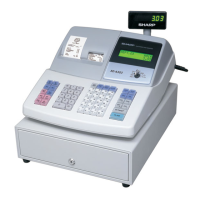
Do you have a question about the Sharp XE-A303 and is the answer not in the manual?
| Type | Electronic Cash Register |
|---|---|
| Display | LCD |
| Departments | 99 |
| Printer | Thermal Printer |
| Paper Width | 58mm |
| Connectivity | USB |
| Memory Backup | Yes, using batteries (usually AA) |
Key points for safe and proper operation of the cash register.
Important notes on memory protection, battery charging, and handling.
Shows the physical layout and components of the cash register.
Details the dual-station thermal printer for receipts and journals.
Explains the function of different mode switches and keys.
Describes the layout and function of all keys on the keyboard.
Explains the information shown on the operator and customer displays.
Describes how to use the drawer lock key to secure the cash drawer.
Instructions for physically setting up the cash register on a stable surface.
Procedure for first-time setup and data initialization of the cash register.
Guide on loading receipt and journal paper rolls into the printer.
Defines key terms and abbreviations used in the manual and programming.
General preparation steps and checks before starting programming.
Instructions on how to set the display language for the register.
Procedure for setting the current date and time on the cash register.
Configuring tax rates, tax systems, and taxable status for departments.
Setting up merchandise departments, classifications, and groups.
Programming item codes (PLUs), subdepartments, prices, and tax status.
Entering custom text for clerk names, logo messages, and function texts.
Settings for decimal point position, rounding systems, and currency.
Step-by-step guide for performing a typical cash sale transaction.
How to enter sales transactions using Price Look-Up (PLU) codes.
How to clear incorrect numeric entries before finalizing.
Voiding the most recent transaction entry immediately after it is made.
Voiding previous transaction entries before finalization.
Voiding the entire transaction before it is finalized.
Manager intervention for entries not handled by standard void functions.
Extra details and notes for performing basic sales entries.
How to handle and interpret error messages and warnings.
Details on entering single items, PLUs, and subdepartments.
How to view the current transaction subtotal during a sale.
Completing sales transactions using cash, cheque, or credit tenders.
Explanation of different VAT and tax calculation systems.
Using features like percentage calculations, deductions, and refunds.
Handling currency exchange, received-on-account, and paid-out entries.
Programming sequences for the AUTO key for transactions or reports.
Managing multiple clerks working on the register simultaneously.
General steps and checks required before starting any programming.
How the register displays programming instructions and prompts.
Setting unique register identifiers and managing consecutive print numbers.
Configuring miscellaneous key functions, print formats, and receipt formats.
Programming features like power save mode and clerk code assignments.
Settings related to currency exchange and the introduction of the Euro.
How to view currently programmed settings and reports.
How the machine behaves and recovers from power interruptions.
Steps to resolve common printer issues like paper errors or head-up conditions.
Best practices for maintaining the printer and using thermal paper.
Procedure for removing old and installing new paper rolls.
Steps to clear paper jams from the printer mechanism.
Instructions for cleaning the print head, sensor, and roller for optimal quality.
How to detach the till and the cash drawer from the register.
Procedure for opening the cash drawer by hand if it does not open automatically.
Guidance on checking common faults before contacting technical support.
